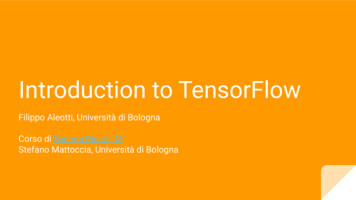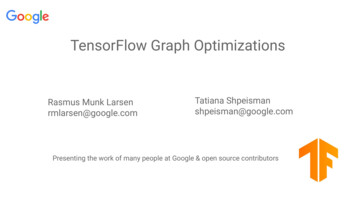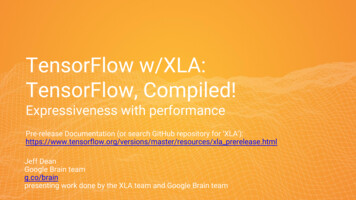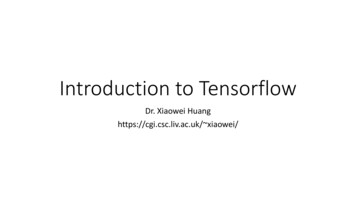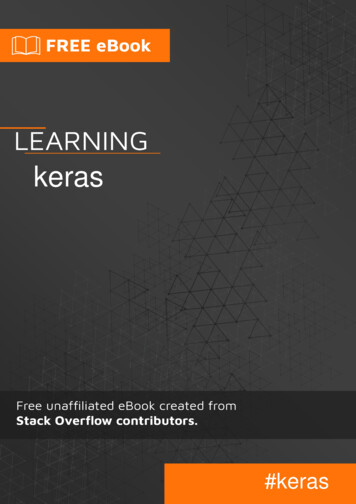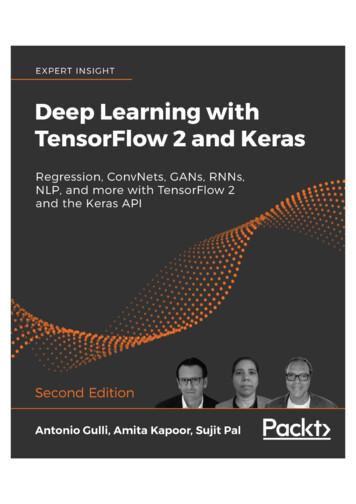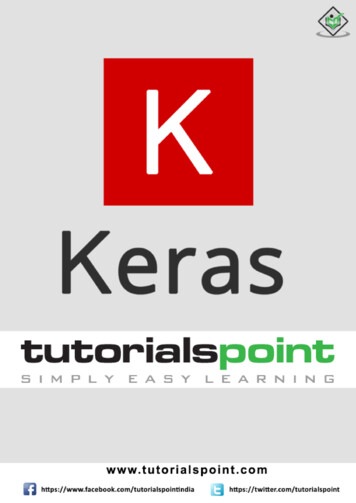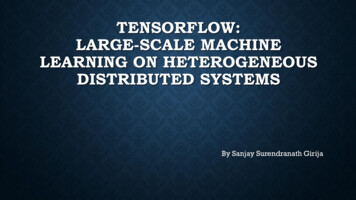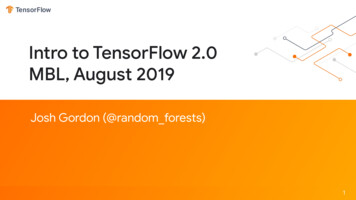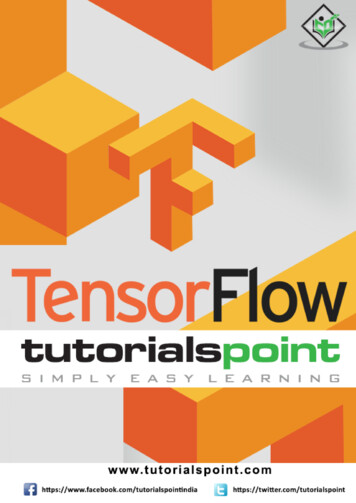
Transcription
TensorFlowi
TensorFlowAbout the TutorialTensorFlow is an open source machine learning framework for all developers. It is usedfor implementing machine learning and deep learning applications. To develop andresearch on fascinating ideas on artificial intelligence, Google team created TensorFlow.TensorFlow is designed in Python programming language, hence it is considered an easyto understand framework.AudienceThis tutorial has been prepared for python developers who focus on research anddevelopment with various machine learning and deep learning algorithms. The aim of thistutorial is to describe all TensorFlow objects and methods.PrerequisitesBefore proceeding with this tutorial, you need to have a basic knowledge of any Pythonprogramming language. Knowledge of artificial intelligence concepts will be a plus point.Copyright & Disclaimer Copyright 2018 by Tutorials Point (I) Pvt. Ltd.All the content and graphics published in this e-book are the property of Tutorials Point (I)Pvt. Ltd. The user of this e-book is prohibited to reuse, retain, copy, distribute or republishany contents or a part of contents of this e-book in any manner without written consentof the publisher.We strive to update the contents of our website and tutorials as timely and as precisely aspossible, however, the contents may contain inaccuracies or errors. Tutorials Point (I) Pvt.Ltd. provides no guarantee regarding the accuracy, timeliness or completeness of ourwebsite or its contents including this tutorial. If you discover any errors on our website orin this tutorial, please notify us at contact@tutorialspoint.comi
TensorFlowTable of ContentsAbout the Tutorial . iAudience . iPrerequisites . iCopyright & Disclaimer . iTable of Contents . ii1.TensorFlow — Introduction . 1Why is TensorFlow So Popular? . 12.TensorFlow — Installation . 33.TensorFlow — Understanding Artificial Intelligence . 8Supervised Learning . 9Unsupervised Learning . 94.TensorFlow — Mathematical Foundations. 11Vector . 11Mathematical Computations . 125.TensorFlow — Machine Learning and Deep Learning . 15Machine Learning . 15Deep Learning. 15Difference between Machine Learning and Deep learning . 16Applications of Machine Learning and Deep Learning . 176.TensorFlow — Basics. 19Tensor Data Structure . 19Various Dimensions of TensorFlow . 20Two dimensional Tensors . 21Tensor Handling and Manipulations . 237.TensorFlow — Convolutional Neural Networks. 25Convolutional Neural Networks . 25ii
TensorFlowTensorFlow Implementation of CNN . 278.TensorFlow — Recurrent Neural Networks . 31Recurrent Neural Network Implementation with TensorFlow . 329.TensorFlow — TensorBoard Visualization . 3610. TensorFlow — Word Embedding . 38Word2vec . 3811. TensorFlow — Single Layer Perceptron . 42Single Layer Perceptron . 4312. TensorFlow — Linear Regression . 47Steps to design an algorithm for linear regression . 4813. TensorFlow — TFLearn and its installation . 5014. TensorFlow — CNN and RNN Difference . 5215. TensorFlow — Keras . 5316. TensorFlow — Distributed Computing . 5617. TensorFlow — Exporting with TensorFlow . 5818. TensorFlow — Multi-Layer Perceptron Learning . 5919. TensorFlow — Hidden Layers of Perceptron . 6320. TensorFlow — Optimizers in TensorFlow . 6721. TensorFlow — XOR Implementation . 6822. TensorFlow — Gradient Descent Optimization . 7123. TensorFlow — Forming Graphs . 7324. TensorFlow — Image Recognition using TensorFlow . 7725. TensorFlow — Recommendations for Neural Network Training . 82iii
1. TensorFlow — IntroductionTensorFlowTensorFlow is a software library or framework, designed by the Google team to implementmachine learning and deep learning concepts in the easiest manner. It combines thecomputational algebra of optimization techniques for easy calculation of manymathematical expressions.The official website of TensorFlow is mentioned below:https://www.tensorflow.org/Let us now consider the following important features of TensorFlow: It includes a feature of that defines, optimizes and calculates mathematicalexpressions easily with the help of multi-dimensional arrays called tensors. It includes a programming support of deep neural networks and machine learningtechniques. It includes a high scalable feature of computation with various data sets. TensorFlow uses GPU computing, automating management. It also includes aunique feature of optimization of same memory and the data used.Why is TensorFlow So Popular?TensorFlow is well-documented and includes plenty of machine learning libraries. It offersa few important functionalities and methods for the same.TensorFlow is also called a “Google” product. It includes a variety of machine learning anddeep learning algorithms. TensorFlow can train and run deep neural networks for1
TensorFlowhandwritten digit classification, image recognition, word embedding and creation ofvarious sequence models.2
2. TensorFlow — InstallationTensorFlowTo install TensorFlow, it is important to have “Python” installed in your system. Pythonversion 3.4 is considered the best to start with TensorFlow installation.Consider the following steps to install TensorFlow in Windows operating system.Step 1: Verify the python version being installed.Step 2: A user can pick up any mechanism to install TensorFlow in the system. Werecommend “pip” and “Anaconda”. Pip is a command used for executing and installingmodules in Python.Before we install TensorFlow, we need to install Anaconda framework in our system.3
TensorFlowAfter successful installation, check in command prompt through “conda” command. Theexecution of command is displayed below:4
TensorFlowStep 3: Execute the following command to initialize the installation of TensorFlow:conda create --name tensorflow python 3.5It downloads the necessary packages needed for TensorFlow setup.Step 4: After successful environmental setup, it is important to activate TensorFlowmodule.activate tensorflowStep 5: Use pip to install “Tensorflow” in the system. The command used for installationis mentioned as below:pip install tensorflow5
TensorFlowAnd,pip install tensorflow-gpuAfter successful installation, it is important to know the sample program execution ofTensorFlow.6
TensorFlowFollowing example helps us understand the basic program creation “Hello World” inTensorFlow.The code for first program implementation is mentioned below: activate tensorflow python (activating python shell) import tensorflow as tf hello tf.constant(‘Hello, Tensorflow!’) sess tf.Session() print(sess.run(hello))7
3. TensorFlow — Understanding ArtificialIntelligenceTensorFlowArtificial Intelligence includes the simulation process of human intelligence by machinesand special computer systems. The examples of artificial intelligence include learning,reasoning and self-correction. Applications of AI include speech recognition, expertsystems, and image recognition and machine vision.Machine learning is the branch of artificial intelligence, which deals with systems andalgorithms that can learn any new data and data patterns.Let us focus on the Venn diagram mentioned below for understanding machine learningand deep learning concepts.Machine learning includes a section of machine learning and deep learning is a part ofmachine learning. The ability of program which follows machine learning concepts is toimprove its performance of observed data. The main motive of data transformation is toimprove its knowledge in order to achieve better results in the future, provide output closerto the desired output for that particular system. Machine learning includes “patternrecognition” which includes the ability to recognize the patterns in data.The patterns should be trained to show the output in desirable manner.Machine learning can be trained in two different ways: Supervised training Unsupervised training8
TensorFlowSupervised LearningSupervised learning or supervised training includes a procedure where the training set isgiven as input to the system wherein, each example is labeled with a desired output value.The training in this type is performed using minimization of a particular loss function, whichrepresents the output error with respect to the desired output system.After completion of training, the accuracy of each model is measured with respect todisjoint examples from training set, also called the validation set.The best example to illustrate “Supervised learning” is with a bunch of photos given withinformation included in them. Here, the user can train a model to recognize new photos.Unsupervised LearningIn unsupervised learning or unsupervised training, include training examples, which arenot labeled by the system to which class they belong. The system looks for the data, whichshare common characteristics, and changes them based on internal knowledge features.This type of learning algorithms are basically used in clustering problems.9
TensorFlowThe best example to illustrate “Unsupervised learning” is with a bunch of photos with noinformation included and user trains model with classification and clustering. This type oftraining algorithm works with assumptions as no information is given.10
4. TensorFlow — Mathematical FoundationsTensorFlowIt is important to understand mathematical concepts needed for TensorFlow beforecreating the basic application in TensorFlow. Mathematics is considered as the heart ofany machine learning algorithm. It is with the help of core concepts of Mathematics, asolution for specific machine learning algorithm is defined.VectorAn array of numbers, which is either continuous or discrete, is defined as a vector. Machinelearning algorithms deal with fixed length vectors for better output generation.Machine learning algorithms deal with multidimensional data so vectors play a crucial role.The pictorial representation of vector model is as shown below:11
TensorFlowScalarScalar can be defined as one-dimensional vector. Scalars are those, which include onlymagnitude and no direction. With scalars, we are only concerned with the magnitude.Examples of scalar include weight and height parameters of children.MatrixMatrix can be defined as multi-dimensional arrays, which are arranged in the format ofrows and columns. The size of matrix is defined by row length and column length. Followingfigure shows the representation of any specified matrix.Consider the matrix with “m” rows and “n” columns as mentioned above, the matrixrepresentation will be specified as “m*n matrix” which defined the length of matrix as well.Mathematical ComputationsIn this section, we will learn about the different Mathematical Computations in TensorFlow.Addition of matricesAddition of two or more matrices is possible if the matrices are of the same dimension.The addition implies addition of each element as per the given position.Consider the following example to understand how addition of matrices works:12
TensorFlowSubtraction of matricesThe subtraction of matrices operates in similar fashion like the addition of two matrices.The user can subtract two matrices provided the dimensions are equal.Multiplication of matricesFor two matrices A m*n and B p*q to be multipliable, n should be equal to p. The resultingmatrix is:C m*qTranspose of matrixThe transpose of a matrix A, m*n is generally represented by AT (transpose) n*m and isobtained by transposing the column vectors as row vectors.13
TensorFlowDot product of vectorsAny vector of dimension n can be represented as a matrix v R n*1.The example of dot product of vectors is mentioned below:14
5. TensorFlow — Machine Learning and DeepLearningTensorFlowArtificial Intelligence is one of the most popular trends of recent times. Machine learningand deep learning constitute artificial intelligence. The Venn diagram shown below explainsthe relationship of machine learning and deep learning:Machine LearningMachine learning is the art of science of getting computers to act as per the algorithmsdesigned and programmed. Many researchers think machine learning is the best way tomake progress towards human-level AI. Machine learning includes the following types ofpatterns: Supervised learning pattern Unsupervised learning patternDeep LearningDeep learning is a subfield of machine learning where concerned algorithms are inspiredby the structure and function of the brain called artificial neural networks.All the value today of deep learning is through supervised learning or learning from labelleddata and algorithms.Each algorithm in deep learning goes through the same process. It includes a hierarchy ofnonlinear transformation of input that can be used to generate a statistical model asoutput.Consider the following steps that define the Machine Learning process:15
TensorFlow Identifies relevant data sets and prepares them for analysis. Chooses the type of algorithm to use. Builds an analytical model based on the algorithm used. Trains the model on test data sets, revising it as needed. Runs the model to generate test scores.Difference between Machine Learning and Deep learningIn this section, we will learn about the difference between Machine Learning and DeepLearning.Amount of dataMachine learning works with large amounts of data. It is useful for small amounts of datatoo. Deep learning on the other hand works efficiently if the amount of data increasesrapidly. The following diagram shows the working of machine learning and deep learningwith the amount of data:Hardware DependenciesDeep learning algorithms are designed to heavily depend on high-end machines unlike thetraditional machine learning algorithms. Deep learning algorithms perform a number ofmatrix multiplication operations, which require a large amount of hardware support.16
TensorFlowFeature EngineeringFeature engineering is the process of putting domain knowledge into specified features toreduce the complexity of data and make patterns that are visible to learning algorithms itworks.Example: Traditional machine learning patterns focus on pixels and other attributesneeded for feature engineering process. Deep learning algorithms focus on high-levelfeatures from data. It reduces the task of developing new feature extractor of every newproblem.Problem Solving ApproachThe traditional machine learning algorithms follow a standard procedure to solve theproblem. It breaks the problem into parts, solve each one of them and combine them toget the required result. Deep learning focusses in solving the problem from end to endinstead of breaking them into divisions.Execution TimeExecution time is the amount of time required to train an algorithm. Deep learning requiresa lot of time to train as it includes a lot of parameters which takes a longer time thanusual. Machine learning algorithm comparatively requires less execution time.InterpretabilityInterpretability is the major factor for comparison of machine learning and deep learningalgorithms. The main reason is that deep learning is still given a second thought before itsusage in industry.Applications of Machine Learning and Deep LearningIn this section, we will learn about the different applications of Machine Learning and DeepLearning. Computer vision which is used for facial recognition and attendance mark throughfingerprints or vehicle identification through number plate. Information Retrieval from search engines like text search for image search. Automated email marketing with specified target identification. Medical diagnosis of cancer tumors or anomaly identification of any chronic disease. Natural language processing for applications like photo tagging. The best exampleto explain this scenario is used in Facebook. Online Advertising.17
TensorFlowFuture Trends With the increasing trend of using data science and machine learning in theindustry, it will become important for each organization to inculcate machinelearning in their businesses. Deep learning is gaining more importance than machine learning. Deep learning isproving to be one of the best techniques in state-of-art performance. Machine learning and deep learning will prove beneficial in research and academicsfield.ConclusionIn this article, we had an overview of machine learning and deep learning with illustrationsand differences also focusing on future trends. Many of AI applications utilize machinelearning algorithms primarily to drive self-service, increase agent productivity andworkflows more reliable. Machine learning and deep learning algorithms include an excitingprospect for many businesses and industry leaders.18
6. TensorFlow — BasicsTensorFlowIn this chapter, we will learn about the basics of TensorFlow. We will begin byunderstanding the data structure of tensor.Tensor Data StructureTensors are used as the basic data structures in TensorFlow language. Tensors representthe connecting edges in any flow diagram called the Data Flow Graph. Tensors are definedas multidimensional array or list.Tensors are identified by the following three parameters:RankUnit of dimensionality described within tensor is called rank. It identifies the number ofdimensions of the tensor. A rank of a tensor can be described as the order or n-dimensionsof a tensor defined.ShapeThe number of rows and columns together define the shape of Tensor.TypeType describes the data type assigned to Tensor’s elements.A user needs to consider the following activities for building a Tensor: Build an n-dimensional array Convert the n-dimensional array.19
TensorFlowVarious Dimensions of TensorFlowTensorFlow includes various dimensions. The dimensions are described in brief below:One dimensional TensorOne dimensional tensor is a normal array structure which includes one set of values of thesame data type.Declaration import numpy as np tensor 1d np.array([1.3, 1, 4.0, 23.99]) print tensor 1dThe implementation with the output is shown in the screenshot below:The indexing of elements is same as Python lists. The first element starts with index of 0;to print the values through index, all you need to do is mention the index number.20
TensorFlow print tensor 1d[0]1.3 print tensor 1d[2]4.0Two dimensional TensorsSequence of arrays are used for creating “two dimensional tensors”.The creation of two-dimensional tensors is described below:Following is the complete syntax for creating two dimensional arrays: import numpy as np tensor 2d 4,15)]) print(tensor 2d)[[ 1 2 3 4][ 4 5 6 7][ 8 9 10 11]21
TensorFlow[12 13 14 15]] The specific elements of two dimensional tensors can be tracked with the help of rownumber and column number specified as index numbers. tensor 2d[3][2]1422
TensorFlowTensor Handling and ManipulationsIn this section, we will learn about Tensor Handling and Manipulations.To begin with, let us consider the following code:import tensorflow as tfimport numpy as npmatrix1 np.array([(2,2,2),(2,2,2),(2,2,2)],dtype 'int32')matrix2 np.array([(1,1,1),(1,1,1),(1,1,1)],dtype 'int32')print (matrix1)print (matrix2)matrix1 tf.constant(matrix1)matrix2 tf.constant(matrix2)matrix product tf.matmul(matrix1, matrix2)matrix sum tf.add(matrix1,matrix2)matrix 3 np.array([(2,7,2),(1,4,2),(9,0,2)],dtype 'float32')print (matrix 3)matrix det tf.matrix determinant(matrix 3)with tf.Session() as sess:result1 sess.run(matrix product)result2 sess.run(matrix sum)result3 sess.run(matrix det)print (result1)print (result2)print (result3)23
TensorFlowOutputThe above code will generate the following output:ExplanationWe have created multidimensional arrays in the above source code. Now, it is importantto understand that we created graph and sessions, which manage the Tensors andgenerate the appropriate output. With the help of graph, we have the output specifyingthe mathematical calculations between Tensors.24
7. TensorFlow — Convolutional NeuralNetworksTensorFlowAfter understanding machine-learning concepts, we can now shift our focus to deeplearning concepts. Deep learning is a division of machine learning and is considered as acrucial step taken by researchers in recent decades. The examples of deep learningimplementation include applications like image recognition and speech recognition.Following are the two important types of deep neural networks: Convolutional Neural Networks Recurrent Neural NetworksIn this chapter, we will focus on the CNN, Convolutional Neural Networks.Convolutional Neural NetworksConvolutional Neural networks are designed to process data through multiple layers ofarrays. This type of neural networks is used in applications like image recognition or facerecognition. The primary difference between CNN and any other ordinary neural networkis that CNN takes input as a two-dimensional array and operates directly on the imagesrather than focusing on feature extraction which other neural networks focus on.The dominant approach of CNN includes solutions for problems of recognition. Topcompanies like Google and Facebook have invested in research and development towardsrecognition projects to get activities done with greater speed.A convolutional neural network uses three basic ideas: Local respective fields Convolution PoolingLet us understand these ideas in detail.CNN utilizes spatial correlations that exist within the input data. Each concurrent layer ofa neural network connects some input neurons. This specific region is called local receptivefield. Local receptive field focusses on the hidden neurons. The hidden neurons processthe input data inside the mentioned field not realizing the changes outside the specificboundary.25
TensorFlowFollowing is a diagram representation of generating local respective fields:If we observe the above representation, each connection learns a weight of the hiddenneuron with an associated connection with movement from one layer to another. Here,individual neurons perform a shift from time to time. This process is called “convolution”.The mapping of connections from the input layer to the hidden feature map is defined as“shared weights” and bias included is called “shared bias”.CNN or convolutional neural networks use pooling layers, which are the layers, positionedimmediately after CNN declaration. It takes the input from the user as a feature map thatcomes out of convolutional networks and prepares a condensed feature map. Poolinglayers helps in creating layers with neurons of previous layers.26
TensorFlowTensorFlow Implementation of CNNIn this section, we will learn about the TensorFlow implementation of CNN. The steps,which require the execution and proper dimension of the entire network, are as shownbelow:Step 1: Include the necessary modules for TensorFlow and the data set modules, whichare needed to compute the CNN model.import tensorflow as tfimport numpy as npfrom tensorflow.examples.tutorials.mnist import input dataStep 2: Declare a function called run cnn(), which includes various parameters andoptimization variables with declaration of data placeholders. These optimization variableswill declare the training pattern.def run cnn():mnist input data.read data sets("MNIST data/", one hot True)learning rate 0.0001epochs 10batch size 50Step 3: In this step, we will declare the training data placeholders with input parameters- for 28 x 28 pixels 784. This is the flattened image data that is drawn frommnist.train.nextbatch().We can reshape the tensor according to our requirements. The first value (-1) tellsfunction to dynamically shape that dimension based on the amount of data passed to it.The two middle dimensions are set to the image size (i.e. 28 x 28).x tf.placeholder(tf.float32, [None, 784])x shaped tf.reshape(x, [-1, 28, 28, 1])y tf.placeholder(tf.float32, [None, 10])Step 4: Now it is important to create some convolutional layers:layer1 create new conv layer(x shaped, 1, 32, [5, 5], [2, 2], name 'layer1')layer2 create new conv layer(layer1, 32, 64, [5, 5], [2, 2],name 'layer2')27
TensorFlowStep 5: Let us flatten the output ready for the fully connected output stage - after twolayers of stride 2 pooling with the dimensions of 28 x 28, to dimension of 14 x 14 orminimum 7 x 7 x,y co-ordinates, but with 64 output channels. To create the fully connectedwith "dense" layer, the new shape needs to be [-1, 7 x 7 x 64]. We can set up someweights and bias values for this layer, then activate with ReLU.flattened tf.reshape(layer2, [-1, 7 * 7 * 64])wd1 tf.Variable(tf.truncated normal([7 * 7 * 64, 1000], stddev 0.03),name 'wd1')bd1 tf.Variable(tf.truncated norm
Step 1: Verify the python version being installed. Step 2: A user can pick up any mechanism to install TensorFlow in the system. We recommend “pip” and “Anaconda”. Pip is a command used for executing and installing modules in Python. Before we install TensorFlow, we need to install Anaconda fr
